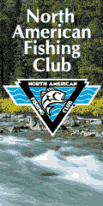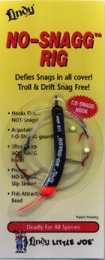












Promotional
Team Favorites
Lodging food and more









|
Rigging with Al Lindner
By Ted Takasaki and Scott Richardson
One score and fifteen years ago, two brothers brought forth on this
nation a new and effective way to catch fish. Used first for walleyes,
the Lindy Rig has been used to catch nearly every species that swims.
The original Lindy Rig has seen some modifications during those 35
years. It’s been rendered “NO-SNAGG” with a re-designed sinker and
snagless hook. It even rattles if you want.
Vibrant glow colors were added for 2003. Other fine-tuning included
the addition of colorful floaters or spinners and returning to the use
of colorful hooks. The original Lindy Rig came with pink hooks, don’t you
know.
But, the basic rig has remained the same, simple fish-catching device
it was when Ron Lindner invented it and introduced it to the angling world
with his brother, Al.
The Lindy Rig equals a sinker, a bead, a swivel, a leader and a hook.
"It’s become a main stay," Al Lindner said. Why? Simply the best
reason there is; "It triggers neutral fish."
As much as we like see those kamikaze moments when fish seem to rush
to commit mass suicide, the reality is that fish are in a neutral to negative
mood much of the time.
That’s especially true during the summer when the watery world that
fish inhabit is alive with newly-hatched, bite-sized fish and insects.
The abundance of forage translates to one thing; "You’ve got to force them
to strike," Lindner said.
Walleyes roaming over the structure you’re targeting might be full
to the gills with food. But when you offer them lively livebait, one or
two out of the group will strike, he said. "If it wiggles long enough,
they’ve got to," Lindner said.
Lindner said small fertile lakes of 500 acres or less are the toughest
locations as summer matures. Forage is plentiful and fish may suspend.
But, he said there are always some walleyes to be caught. In Minnesota,
Gull Lake, Whitefish, Leech, Edwards, Cass and Bemidji are places to target.
Whether you’re in Minnesota or not, anywhere you target walleyes during
the warm months, try concentrating on the structures that hold the fish,
which are points, reefs and mid-lake humps. Shallow weedlines produce
fish as well.
No matter where you fish, the principle of Lindy rigging is the same
— let the bait do the fishing. Whether you are using a nightcrawler, leech
or minnow, the bait must be lively. Change it often.
Consider another major variable in the formula of the Lindy Rig — snell
length. Size does matter, and bigger is not always better.
Did you know the original Lindy rig came with a 24-inch leader? Only
later was it stretched to 36 inches. Both Al and Ron Lindner believe
that one of the most overlooked and potent of all Lindy-Rig modifications
is to shorten the leader even more than the originals.
"Ten-inch snells, even smaller," said Al Lindner. "The most amazing
thing is how well short snells work."
How short? When Ron Lindner first experimented with the tactic, he
used rigs with a leader length of 6 inches to 1 foot. "I like the
bait near the sinker itself," he said. "I think fish are attracted to the
thumping. In effect, you are fishing it like a jig," he said.
But unlike a jig, the Lindy rig lets the bait move naturally in the
water.
That short leader can prove even more effective with the appearance
of the Techni-Glo Lindy Rig on the market. Sinkers come in shocking yellow
and ruby red. "The sinker gets the attention," Al Lindner said.
Another advantage of a short leader — you can set the hook right away
instead of waiting long, heat-thumping moments for the fish to eat the
bait.
Shorter is best, Al Lindner said, in water 18 to 12 feet deep and even
less. Drag it as slow you can. Let the live bait do its job. You can use
a lighter sinker and let more line out to increase the angle of the line
with the water’s surface to avoid spooking fish.

Lindy Little Joe
No
Snagg Rig |
Use heavier weights and stay more vertical over the bait in deeper
water to maintain better control and to avoid snags when using the original
Lindy sinker. Or switch to a NO-SNAGG sinker.Rather than lengthening the
snell for really finicky fish, use lighter line and smaller hooks than
the #6 short-shanked hooks that are usual when rigging with minnows and
nightcrawlers or the #8 used with leeches hooked through their suckers
to let them to swim. Four-pound monofilament and a #10 hook might yield
more strikes.Unsure which length is best to start? Begin with 36 inches.
If there’s two people in the boat, have one try long and one shorter until
the effective length is found.Longer snells are good when you use redtail
chubs, which are a great summertime baits, Al Lindner said. Use a heavy
1-ounce weight to anchor the rig. Add a 3- to 4-foot snell, tail-hook the
bait and hold on."That will trigger the fish," Al Lindner said. Another
occasion to use longer snells is when fish suspend a few feet off the bottom.
Thirty-five years and counting - older is often better when it comes to
the Lindy Rig. |
Fish
Clix Banner Exchange
Walleyes Inc. website is maintained
by Randy
Tyler Fishing the In-Fisherman Professional Walleye Circuit, Masters
Walleye Circuit and the Wal Mart RCL Circuit. All rights reserved.Copyright
1999/2003
Please visit these site sponsors
Daiichi/Tru-Turn Hooks,
Lindy
Little Joe,
R-A.M Mounting Systems,
Ranger
boats, Mercury Outboards,Bedford
Sales , Church Tackle, Panther
Marine Products,
Webfoots body sock,
Bait
Rigs Tackle ,Dual Pro Charging Systems,
Daiwa
Rods and Reels,
Driftcontrol
Wind socks,
Trojan Batteries
|


